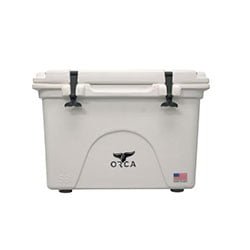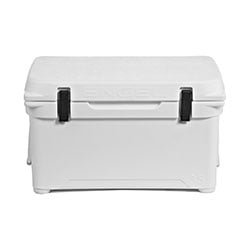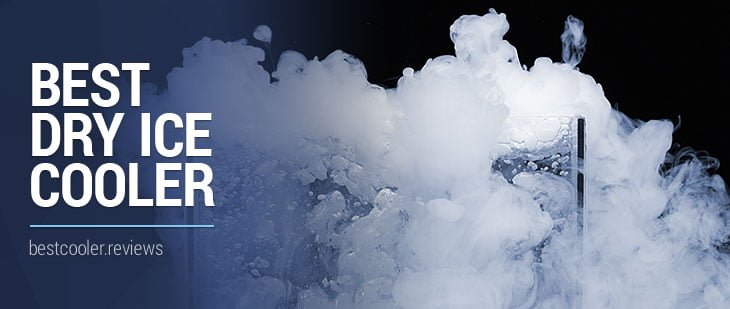Affiliate Disclosure: Some of the links in this post may be affiliate links. As an Amazon Associate, we earn from qualifying purchases. Learn more here.
Some people might remember dry ice from their days of high school chemistry, when their wacky, goofball teacher would pull it out of a cooler during a class presentation and blow everyone’s mind.
As it turns out, (this might come as a surprise to some), dry ice actually has practical uses, other than turning run-of-the-mill teachers into Bill Nye the Science Guy for a day. In this article, we’ll go over what exactly dry ice is, how it can be used conveniently and efficiently, and what are a few of the best dry ice coolers out there on the market today.
NOTE: Keep in mind that dry ice isn’t necessarily dangerous, but for maximum safety and efficiency it should only be used in approved dry ice coolers.
Best Dry Ice Cooler: Our Top Picks


Orca – Dry Ice Compatible Cooler
The 58-quart Orca (TP058ORC) is a pretty expensive pick, but out of the various ones we’ve used over the years, it’s got to be the best cooler for dry ice we’ve ever tried.
We’re not exactly clear on the scientifics behind all of it, but Orca claims to incorporate a unique form of integrated insulation in their rotomold designs, and for whatever reason that combined with the gasket they use seems to minimize the sublimation (‘melting’) of dry ice, keeping it in its solid state longer than any other cooler we’ve used.
Aside from its specialty-themed coolers, the 58-quart Orca is one of six ‘dry ice compatible’ models they offer, the others being the 20, 26, 40, 75, and 140-quart varieties.
Since they’re marginally lighter than Yeti coolers, we like to use dry ice with the Orca whenever we’re really trying to minimize weight for a trip. (We’ll get into more specifics about it later, but dry ice offers double the ‘cooling power’ of regular ice, so you can get away with using half the amount of ice – and half the amount of weight – to achieve the same temperature as regular ice.


RTIC Coolers – Cheap Dry Ice Cooler
RTIC’s roto-molded coolers are actually a good dry ice option as well, and receive our nomination for the best cheap dry ice cooler (Amazon link).
Technically you could use any cooler for dry ice, but cheaper ones with insufficient insulation and an inadequate seal will allow the dry ice ‘smoke’ to escape super quickly, making it hardly worth spending the extra money on dry ice over ‘regular’ water ice.
Not surprisingly, we’ve found that RTIC’s roto-molded dry ice chest is more than capable of handling the extra ‘stresses’ of ultra-cold sublimation. If you’ve really been wanting to get in on the buzz of dry ice, but haven’t been wanting to splash the cash on one of the big names, the RTIC lineup is definitely worth checking out.


Engel Coolers – Dry Ice Cooler for Medic Teams and EMS Vehicles
Another really good option is the High Performance ENG35 from Engel Coolers. We’ve had plenty of success with dry ice using this thing, and it’s quickly become one of the favorites for commercial fisherman and backcountry guides who are catching on to the advantages of dry ice over regular ice (we’ll talk about these advantages in detail below).
Engels are also the most popular dry ice cooler for medic teams and EMS vehicles, so you know they can be trusted to come through even under the most crucial of situations.
Like we mentioned earlier, excellent insulation and a bombproof seal/gasket are an absolute must when thinking about using dry ice in a cooler, and the ArcticVault Gasket on all the High-Performance Engels more than meet the demands of the challenge.
One really important thing to consider about dry ice is the fact that it doesn’t melt, it sublimates. This means there’s no liquid intermediate between the solid and gaseous state – it goes straight from solid to gas. This is why you need a cooler with a state of the art gasket system to handle dry ice, and the Engel High Performance line has one of the best out there.
Another favorite feature of Engel’s performance coolers are the non-marking Cornerstone feet. Every top-of-the-line cooler will have some sort of ‘non-skid’ bottom, but the specific design from Engel is far and away the most effective, in our opinion. Certainly one of the reason why they’re so popular among professional guides and charter fishermen.


Pelican’s ProGear Elite – Dry Ice Cooler for Long Road Trips
Moving on, it sounds a little ‘spoiled’ of us to say this, but Pelican’s ProGear Elite 45-quart is definitely our go-to dry ice cooler for long road trips. (Yeah, it is pretty sweet to have a specific cooler to choose from for every different situation).
Every high-end roto molded cooler out there has some kind of UV protection layer on it to minimize sunlight penetration, but we’ve found the ProGear Elite series to be the most effective, without question. Just like water ice, ambient radiation from the sun is detrimental to the ‘lifespan’ of dry ice, and strapping a cooler to the bed of your truck for a 900 mile road trip is about as brutal as it can get conditions-wise.
Obviously one of the best things about Pelican coolers is their notoriously awesome lifetime guarantee, but we also love the fact that they have so many different colors to choose from (including this crazy pink) for each different size.


Igloo Yukon – One of the Best Dry Ice Cooler
And lastly, our final pick for the best dry ice cooler out there goes to the Igloo Yukon Cold Locker series – another great value option that offers decent competition to the RTIC lineup.
These are bigger coolers, and like the Engels they’re becoming really popular among guides and fishing charters – relatively inexpensive, yet quality enough to handle the most brutal of treatment.
Like we mentioned earlier, people who rely on ice everyday as part of their livelihood (commercial fisherman, wilderness guides, etc), are definitely starting to catch on to the advantages of dry ice, and the Cold Locker series is definitely spiking in popularity as they’re super reasonably priced and perform nearly as well with dry ice as a Pelican or an Orca.
The 360-degree compression seal gasket, combined with Igloo’s new MaxCold insulation (no ‘thin spots’ through the entire cooler), gave the Yukon an A-grade passing score on our rigorous dry ice compatibility test.
How To Use Dry Ice in a Cooler
Alright, now that we’ve dished out our overall top picks for the best dry ice cooler on the market, let’s actually talk about what dry ice is, and how to properly go about using it in a cooler.
What is Dry Ice?
Dry ice is frozen carbon dioxide, plain and simple. The unique thing about it is it doesn’t melt like water ice – it sublimates (goes straight from solid to gas). This is why it gives off that cool dry ice ‘smoke’.
Carbon dioxide does have a liquid state, but the atmospheric pressure has to be really high in order for it to condense into a liquid – much higher than you’ll ever find in a ‘normal’ environment.
Is Dry Ice Safe to Use?
To put it briefly, yes – dry ice is definitely safe to use in a cooler. (It’s the same chemical that’s used to give soda its ‘fizz’, after all).
The only thing you really have to keep in mind is that it’s too cold to handle without gloves. Whereas water freezes at 32-degrees Fahrenheit, carbon dioxide freezes at a mind-numbingly chilling -109.3-degrees Fahrenheit – without gloves, you’ll get pretty brutal frost bite trying to handle it with your bare hands.
Also, the ‘smoke’ from dry ice can potentially be dangerous if you inhale loads of it in a short amount of time, so keep in mind to try and use it in a pretty well-ventilated area. (The only situation where this might be an issue is if you’re traveling in a car for a really long period of time with the windows rolled up).
Where Do You Get Dry Ice?
Dry ice isn’t hard to find by any means – most major grocery store carries it (as does Wal-Mart and Costco). However, if you’re in a more rural area your best bet might be to just to call around or hop on Google and search ‘where to buy dry ice in _____’.
As far as price, it’s definitely more expensive than regular ice, but it’s still fairly reasonable – usually about $2 a pound.
How Much Dry Ice Should You Use?
This can be a little tricky to judge, especially for first-timers. Most places that sell dry ice sell it in 10-inch squares, and one 10” square weighs about 10 lbs.
A general rule of thumb is to use one 10” square of dry ice for every 15” of cooler length. So for a standard 40-quart cooler, this would come out to about 2 squares or 20 lbs of dry ice.
How to Put Dry Ice in a Cooler
It really doesn’t matter whether you put your dry ice blocks below or on top of your food/drinks (although Yeti recommends to put it on top), but you’ll definitely want to wrap it in newspaper or towels before it goes in the cooler. And remember, always wear long sleeves and gloves when handling it.
Also, this is true for any kind of ice, but you really want to avoid creating air pockets when using dry ice if you want it to stay in its solid state for as long as possible.
Don’t Freeze Your Food!
A lot of people underestimate how cold dry ice actually is. If not packed properly, it’ll freeze out your sandwich or drinks in no time at all, and it’s even been known to blow out the thermostat in freezers. (This is why you need to wrap it well in towels before packing). Actually, we’ve heard from a lot of people that like to put it in a soft-sided cooler first, and then add it to the bigger cooler they’re going to use.
How Long Does Dry Ice Last?
Generally speaking, dry ice has a much shorter ‘lifespan’ than regular ice. Even in the best of the best dry ice coolers (like our picks above), expect everything to stay frozen for only about 48hrs, max.
Best Cooler for Dry Ice – Summary
Alright, so if we really had to choose a single, solitary top pick for the best dry ice cooler, we’ll go ahead and go with the Orca 58-quart (this one), although any size Orca will work equally as well with dry ice.
Like we mentioned in the review, whatever scientifics Orca’s got going on with their insulation, in our experience it definitely seems to be the most effective at minimizing (or at least slowing down) sublimation.
Whichever cooler you do decide on, we definitely recommend giving dry ice a shot at least once – even if you’re just trying to show off to your buds!
Disclaimers
All product names, logos, and brands are property of their respective owners. All company, product and service names used in this website are for identification purposes only. Use of these names, logos, and brands does not imply endorsement.
It is our policy to make every effort to respect the copyrights of outside parties. If you believe that your copyright has been misused, please provide us with a message stating your position and we will endeavor to correct any misuse immediately.
Some of the links in this post are affiliate links. As an Amazon Associate, we earn from qualifying purchases. This means if you click on the link and purchase the item, we may receive an affiliate commission, at no extra cost to you. This helps us keep this website alive. Learn more here.


